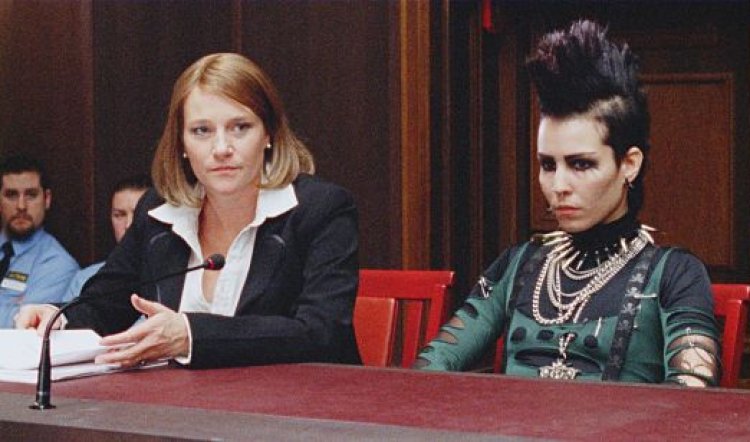
The Girl Who Kicked the Hornet’s Nest
THE GIRL WHO KICKED THE HORNET’S NEST, starring Noomi Rapace, Mickael Nyqvist. Directed by Daniel Alfredson, 2hr 27min - Rated MA
ANYONE ELSE feeling a bit Stieg Larssoned out? Of course we are all lining up (reasonably) eagerly for the third movie in The Girl Who series, based on the final book of the best selling Millennium Trilogy. You have to see it out, don’t you? It’s the least we can do for Salander, and for Noomi Rapace for that matter, who has had to immerse herself over such a long period in the warzone that is Lizbeth Salander’s nightmare existence. She’s been battered, tortured, raped, stabbed and shot, last time round, three times. And buried. And given that the cybergeek character she inhabits with such stroppy conviction is so badly damaged and incandescent with rage that she barely speaks, she’s had to do most of her acting using only eyes, piercings, and keyboard and texting fingers.
So we have to go back for more, even if the second movie (The Girl Who Played With Fire) proved to be a bit by the numbers police procedural, without the sense of place that stamped such a brooding mood on the sombre scenario introduced in the first (The Girl With the Dragon Tattoo). The director of the original movie, Niels Arden Oplev, had ordered up some rather gorgeous cinematography to set the scene, and the vast lowering skies and snowscapes of the Swedish backdrop effectively bled plenty of eerie atmospherics into the unfolding saga. On the other hand, the first movie also featured some uncomfortably explicit sexual violence, which was barely this side of exploitation and drove some viewers right out of the cinema.
Director Daniel Alfredson, who took over the series for the second movie, toned that down marginally and got on with briskly developing the busy plot. But he wasn’t too bothered about toning down the violence, and lost it completely when it came to the horrorshow finale, which was way too Nightmare on Elm Street to be taken seriously. Remember the bloodied hand erupting from the grave? And Salander, gathering her shot-up body bits together and lurching like Terminator woman back into the fray, summoning up her inner axe-murderer to wreak vengeance on her loathsome father? When we left her, the rescue helicopters were circling and Mikael Blomkvist – her sometime lover and crusading leftie journo defender – was presiding, stricken, over what was clearly her demise. Or not. Which of course you knew, because there was still another book/movie to play out, and if you’d read all three you already knew exactly what was going to happen at the end of the movie you hadn’t seen yet.
Inevitably the third movie feels like a re-cap. Certainly it involves large slabs of backstory to set it up. And apart from one last eleventh hour burst of drama, there is necessarily less action, since the injured Salander spends half the time in bed, rehab andprison doing push-ups, and most of the other half in court, when she is finally brought to trial. The trial has been engineered by the coven of political miscreants and corrupt security forces whose machinations have, from the first, been stymied by Salander, and who still can’t understand how this meddlesome girl, unwisely dismissed as a mere footnote in their grand plans, has continued to bedevil them. The mostly subdued court scenes are rather anti-climactic too, re-visiting what we have already seen, while Blomkvist and the team at Millennium magazine work behind the scenes to come up with the proof that will clinch the case.
There is, though, the galvanizing presence of Salander herself, not only resplendent in Sunday-best anti-establishment uniform of gleaming leather, extra piercings and intricately assembled Goth makeup, but also, finally, talking. Not exactly talking up a storm, but spitting out her court responses with envenomed precision, incisively demolishing the slippery wordspinning of her chief antagonist, the sleazy shrink who introduced her to hell when he locked her up in an asylum and abused her as a child.
It is interesting to consider how much time we’ve all spent travelling down the labyrinthine byways contrived by Stieg Larsson in his bid to fictionalise the troubling themes of official corruption and secrecy he had pursued in his real life as an investigative journalist in Sweden. Certainly for those hooked on the books, the films came as something of a relief, considering the gap left in our reading lives when we’d curled up for so long with the long-winded narrative and finally devoured the third hefty book in the series.

It seems to be all about the lure of serials. We love a continuing narrative. Charles Dickens, always strapped for cash, was onto that when he churned out serialised episodes of his books for the monthly magazines ahead of publication in order to pay the family bills. The fact that Stieg Larsson died before his books even made it onto the world market had apparently no effect. No personal appearances, no book signings were necessary. Overly detailed and chunky notwithstanding, once we got a taste for the adventures of Salander, her mega-gigabyte brain and her geek’s geek sidekick Plague, we were eager for more. (Even if we were a bit disconcerted to think that the money was all going to that awful family of his, that one pictures rolling about their mansions, waist-deep in ill-gotten dollars while engaged in a slanging match with the woman who shared Larsson’s life and to whom most of the moolah should be directed.)
But even if we’re suckers for what happened next, we may prove more resistant when what happens next is that the Americans are about to unveil their remake (as you do, in Tinseltown, when you’re short of ideas and a foreign film is a hit). Plus two more to come if the first, directed by David Fincher, is a winner, as they attempt to cash in on the Swedish phenomenon, matching bums on cinema seats to the squillions of fans they know are out there; even if they’ve already seen the Swedish original on the screen and re-watched it on DVD.
Re-makes don’t have the same pulling power as serials. And this one is up against it. Can anyone replicate the weirdly captivating Noomi Rapace and her brave, uncompromising performance as the unsinkable Salander? Is Daniel Craig, now stamped indelibly with the jokey 007 brand, likely to eschew flash and dash for the quieter strength Mikael Nyqvist brings to Salander’s crusader? And do we want to see Salander sharing centre stage with James Bond anyway? It was women, after all, and the female warrior as hero in particular, that Stieg Larsson set out to honour as he crucified the corruption of the male establishment. Let’s hope the Americans note that in his serious preface to the books, Larsson, whose initial notion was to specifically highlight the ugliness of men who hate women, drew attention to the fact that history, and Hollywood, have missed a significant slab of social history in failing to deal with women who have defied conventional gender distinctions and fought in life and wars on the same terms as men.
But if Larsson might have been a tad disappointed that his message was somewhat diluted in the Swedish Underbelly reading the films have inevitably favoured, you can’t help feeling he’d be delighted that, thanks to Rapace, his spiky heroine is firmly embedded in the popular culture landscape, raising a be-gloved middle figure in the direction of the Establishment. After all, as he noted in that same preface, inequities continue. Even today, he tells us, eyebrow raised, it can cause controversy having a woman on a Swedish moose hunt.
Onyer Stieg.



